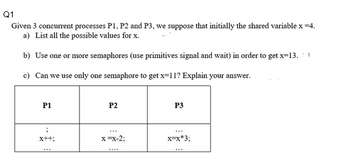
Computer Networking: A Top-Down Approach (7th Edition)
7th Edition
ISBN: 9780133594140
Author: James Kurose, Keith Ross
Publisher: PEARSON
expand_more
expand_more
format_list_bulleted
Question

Transcribed Image Text:Q1
Given 3 concurrent processes P1, P2 and P3, we suppose that initially the shared variable x =4.
a) List all the possible values for x.
b) Use one or more semaphores (use primitives signal and wait) in order to get x=13.1
c) Can we use only one semaphore to get x=11? Explain your answer.
P1
;
...
P2
x=x-2;
P3
x=x*3;
...
Expert Solution
This question has been solved!
Explore an expertly crafted, step-by-step solution for a thorough understanding of key concepts.
Step by stepSolved in 3 steps with 2 images

Knowledge Booster
Similar questions
- Assuming that we have a list of audio music channels, and the user system wants to traverse them one after another or on a channel- For instance, some user systems want only English channels to function and do not wantto process other kinds of channels. Thus, we can supply the client with a collection of channels and let them publish the channels through it and determine if they will be processed.Which design pattern you should adopt? Describe with respect to the full consistent format.arrow_forwardPLS explain WHY my answer is wrong and what I can do differently next time so that I can do better next time and provide the correct answer for this question that is incorrect.arrow_forwardPlease help with this question!! Please provide explanations as well!arrow_forward
- Consider a computer environment in which there are 4 magnetic drives, 2 printers, 3 scanners, and 1 optical drive. Three processes P1, P2, P3 are using these resources. At any point in time, the allocations and requests for these resources are as follows. Allocations: Magnetic drive Printer Scanner Optical drive P1 1 P2 2 1 P3 1 Requests: Magnetic drive 2 Printer Scanner Optical drive P1 1 P2 1 1 P3 2 1 Is there any way that the processes can complete without deadlock? If yes, explain how. If not, explain why not.arrow_forwardWrite a C program that takes a list of command line arguments, each of which is the full path of a command (such as /bin/ls, /bin/ps, /bin/date, /bin/who, /bin/uname etc). Assume the number of such commands is N, your program would then create N direct child processes (ie, the parent of these child processes is the same original process), each of which executing one of the N commands. You should make sure that these N commands are executed concurrently, not sequentially one after the other. The parent process should be waiting for each child process to terminate. When a child process terminates, the parent process should print one line on the standard output stating that the relevant command has completed successfully or not successfully (such as "Command /bin/who has completed successfully", or "Command /bin/who has not completed successfully"). Once all of its child processes have terminated, the parent process should print "All done, bye-bye!" before it itself terminates. Note: do…arrow_forwardCode must be in C/C++ language using MPI Suppose comm_sz = 8 and the vector x = (0,1,2,...,15) has been distributed among the processes using a block distribution. Implement an allgather operation using a butterfly structured communication (see diagram below) and point-to-point communication functionsarrow_forward
arrow_back_ios
arrow_forward_ios
Recommended textbooks for you
 Computer Networking: A Top-Down Approach (7th Edi...Computer EngineeringISBN:9780133594140Author:James Kurose, Keith RossPublisher:PEARSON
Computer Networking: A Top-Down Approach (7th Edi...Computer EngineeringISBN:9780133594140Author:James Kurose, Keith RossPublisher:PEARSON Computer Organization and Design MIPS Edition, Fi...Computer EngineeringISBN:9780124077263Author:David A. Patterson, John L. HennessyPublisher:Elsevier Science
Computer Organization and Design MIPS Edition, Fi...Computer EngineeringISBN:9780124077263Author:David A. Patterson, John L. HennessyPublisher:Elsevier Science Network+ Guide to Networks (MindTap Course List)Computer EngineeringISBN:9781337569330Author:Jill West, Tamara Dean, Jean AndrewsPublisher:Cengage Learning
Network+ Guide to Networks (MindTap Course List)Computer EngineeringISBN:9781337569330Author:Jill West, Tamara Dean, Jean AndrewsPublisher:Cengage Learning Concepts of Database ManagementComputer EngineeringISBN:9781337093422Author:Joy L. Starks, Philip J. Pratt, Mary Z. LastPublisher:Cengage Learning
Concepts of Database ManagementComputer EngineeringISBN:9781337093422Author:Joy L. Starks, Philip J. Pratt, Mary Z. LastPublisher:Cengage Learning Prelude to ProgrammingComputer EngineeringISBN:9780133750423Author:VENIT, StewartPublisher:Pearson Education
Prelude to ProgrammingComputer EngineeringISBN:9780133750423Author:VENIT, StewartPublisher:Pearson Education Sc Business Data Communications and Networking, T...Computer EngineeringISBN:9781119368830Author:FITZGERALDPublisher:WILEY
Sc Business Data Communications and Networking, T...Computer EngineeringISBN:9781119368830Author:FITZGERALDPublisher:WILEY

Computer Networking: A Top-Down Approach (7th Edi...
Computer Engineering
ISBN:9780133594140
Author:James Kurose, Keith Ross
Publisher:PEARSON

Computer Organization and Design MIPS Edition, Fi...
Computer Engineering
ISBN:9780124077263
Author:David A. Patterson, John L. Hennessy
Publisher:Elsevier Science

Network+ Guide to Networks (MindTap Course List)
Computer Engineering
ISBN:9781337569330
Author:Jill West, Tamara Dean, Jean Andrews
Publisher:Cengage Learning

Concepts of Database Management
Computer Engineering
ISBN:9781337093422
Author:Joy L. Starks, Philip J. Pratt, Mary Z. Last
Publisher:Cengage Learning

Prelude to Programming
Computer Engineering
ISBN:9780133750423
Author:VENIT, Stewart
Publisher:Pearson Education

Sc Business Data Communications and Networking, T...
Computer Engineering
ISBN:9781119368830
Author:FITZGERALD
Publisher:WILEY